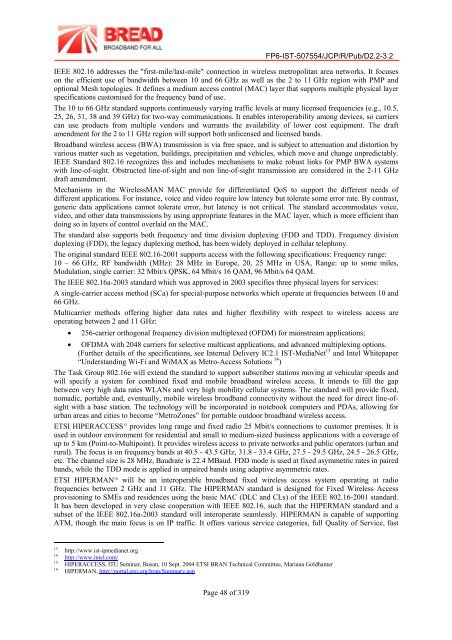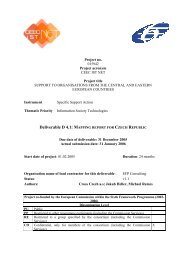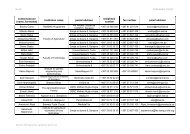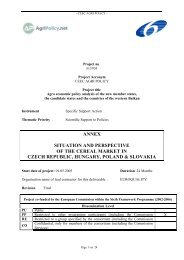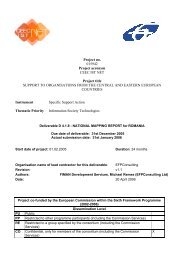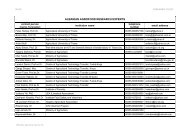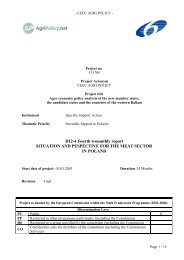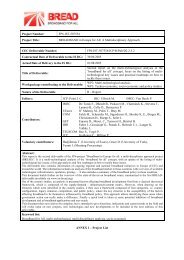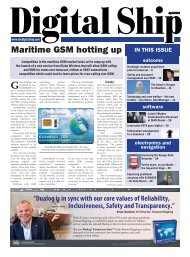Project Number: FP6-IST-507554 Project Title: BROADBAND in ...
Project Number: FP6-IST-507554 Project Title: BROADBAND in ...
Project Number: FP6-IST-507554 Project Title: BROADBAND in ...
Create successful ePaper yourself
Turn your PDF publications into a flip-book with our unique Google optimized e-Paper software.
Page 48 of 319<br />
<strong>FP6</strong>-<strong>IST</strong>-<strong>507554</strong>/JCP/R/Pub/D2.2-3.2<br />
IEEE 802.16 addresses the "first-mile/last-mile" connection <strong>in</strong> wireless metropolitan area networks. It focuses<br />
on the efficient use of bandwidth between 10 and 66 GHz as well as the 2 to 11 GHz region with PMP and<br />
optional Mesh topologies. It def<strong>in</strong>es a medium access control (MAC) layer that supports multiple physical layer<br />
specifications customised for the frequency band of use.<br />
The 10 to 66 GHz standard supports cont<strong>in</strong>uously vary<strong>in</strong>g traffic levels at many licensed frequencies (e.g., 10.5,<br />
25, 26, 31, 38 and 39 GHz) for two-way communications. It enables <strong>in</strong>teroperability among devices, so carriers<br />
can use products from multiple vendors and warrants the availability of lower cost equipment. The draft<br />
amendment for the 2 to 11 GHz region will support both unlicensed and licensed bands.<br />
Broadband wireless access (BWA) transmission is via free space, and is subject to attenuation and distortion by<br />
various matter such as vegetation, build<strong>in</strong>gs, precipitation and vehicles, which move and change unpredictably.<br />
IEEE Standard 802.16 recognizes this and <strong>in</strong>cludes mechanisms to make robust l<strong>in</strong>ks for PMP BWA systems<br />
with l<strong>in</strong>e-of-sight. Obstructed l<strong>in</strong>e-of-sight and non l<strong>in</strong>e-of-sight transmission are considered <strong>in</strong> the 2-11 GHz<br />
draft amendment.<br />
Mechanisms <strong>in</strong> the WirelessMAN MAC provide for differentiated QoS to support the different needs of<br />
different applications. For <strong>in</strong>stance, voice and video require low latency but tolerate some error rate. By contrast,<br />
generic data applications cannot tolerate error, but latency is not critical. The standard accommodates voice,<br />
video, and other data transmissions by us<strong>in</strong>g appropriate features <strong>in</strong> the MAC layer, which is more efficient than<br />
do<strong>in</strong>g so <strong>in</strong> layers of control overlaid on the MAC.<br />
The standard also supports both frequency and time division duplex<strong>in</strong>g (FDD and TDD). Frequency division<br />
duplex<strong>in</strong>g (FDD), the legacy duplex<strong>in</strong>g method, has been widely deployed <strong>in</strong> cellular telephony.<br />
The orig<strong>in</strong>al standard IEEE 802.16-2001 supports access with the follow<strong>in</strong>g specifications: Frequency range:<br />
10 – 66 GHz, RF bandwidth (MHz): 28 MHz <strong>in</strong> Europe, 20, 25 MHz <strong>in</strong> USA, Range: up to some miles,<br />
Modulation, s<strong>in</strong>gle carrier: 32 Mbit/s QPSK, 64 Mbit/s 16 QAM, 96 Mbit/s 64 QAM.<br />
The IEEE 802.16a-2003 standard which was approved <strong>in</strong> 2003 specifies three physical layers for services:<br />
A s<strong>in</strong>gle-carrier access method (SCa) for special-purpose networks which operate at frequencies between 10 and<br />
66 GHz.<br />
Multicarrier methods offer<strong>in</strong>g higher data rates and higher flexibility with respect to wireless access are<br />
operat<strong>in</strong>g between 2 and 11 GHz:<br />
• 256-carrier orthogonal frequency division multiplexed (OFDM) for ma<strong>in</strong>stream applications;<br />
• OFDMA with 2048 carriers for selective multicast applications, and advanced multiplex<strong>in</strong>g options.<br />
(Further details of the specifications, see Internal Delivery IC2.1 <strong>IST</strong>-MediaNet 13 and Intel Whitepaper<br />
“Understand<strong>in</strong>g Wi-Fi and WiMAX as Metro-Access Solutions 14 )<br />
The Task Group 802.16e will extend the standard to support subscriber stations mov<strong>in</strong>g at vehicular speeds and<br />
will specify a system for comb<strong>in</strong>ed fixed and mobile broadband wireless access. It <strong>in</strong>tends to fill the gap<br />
between very high data rates WLANs and very high mobility cellular systems. The standard will provide fixed,<br />
nomadic, portable and, eventually, mobile wireless broadband connectivity without the need for direct l<strong>in</strong>e-ofsight<br />
with a base station. The technology will be <strong>in</strong>corporated <strong>in</strong> notebook computers and PDAs, allow<strong>in</strong>g for<br />
urban areas and cities to become “MetroZones” for portable outdoor broadband wireless access.<br />
ETSI HIPERACCESS15 provides long range and fixed radio 25 Mbit/s connections to customer premises. It is<br />
used <strong>in</strong> outdoor environment for residential and small to medium-sized bus<strong>in</strong>ess applications with a coverage of<br />
up to 5 km (Po<strong>in</strong>t-to-Multipo<strong>in</strong>t). It provides wireless access to private networks and public operators (urban and<br />
rural). The focus is on frequency bands at 40.5 - 43.5 GHz, 31.8 - 33.4 GHz, 27.5 - 29.5 GHz, 24.5 - 26.5 GHz,<br />
etc. The channel size is 28 MHz, Baudrate is 22.4 MBaud. FDD mode is used at fixed asymmetric rates <strong>in</strong> paired<br />
bands, while the TDD mode is applied <strong>in</strong> unpaired bands us<strong>in</strong>g adaptive asymmetric rates.<br />
ETSI HIPERMAN16 will be an <strong>in</strong>teroperable broadband fixed wireless access system operat<strong>in</strong>g at radio<br />
frequencies between 2 GHz and 11 GHz. The HIPERMAN standard is designed for Fixed Wireless Access<br />
provision<strong>in</strong>g to SMEs and residences us<strong>in</strong>g the basic MAC (DLC and CLs) of the IEEE 802.16-2001 standard.<br />
It has been developed <strong>in</strong> very close cooperation with IEEE 802.16, such that the HIPERMAN standard and a<br />
subset of the IEEE 802.16a-2003 standard will <strong>in</strong>teroperate seamlessly. HIPERMAN is capable of support<strong>in</strong>g<br />
ATM, though the ma<strong>in</strong> focus is on IP traffic. It offers various service categories, full Quality of Service, fast<br />
13 http://www.ist-ipmedianet.org<br />
14 http://www.<strong>in</strong>tel.com/<br />
15 HIPERACCESS, ITU Sem<strong>in</strong>ar, Busan, 10 Sept. 2004 ETSI BRAN Technical Committee, Mariana Goldhamer<br />
16 HIPERMAN, http://portal.etsi.org/bran/Summary.asp


